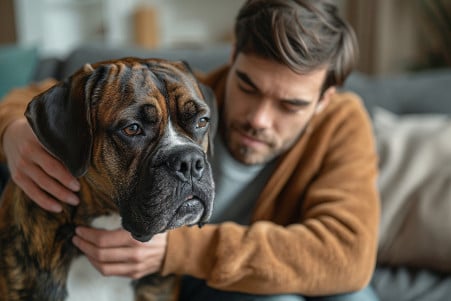Is Your Dog Making a Coughing Sound Like a Hairball? Here's What It Could Mean
31 March 2024 • Updated 30 March 2024

Even though the sound your dog is making is similar to a cat coughing up a hairball, it turns out that the cause of that strange hacking noise could be more serious. For example, dogs can experience reverse sneezing, which is an episode of repeated and rapid inhalation that sounds like the dog is trying to inhale while sneezing - it can be scary, but it's not harmful as long as it goes away quickly. On the other hand, if your dog is coughing, gagging, or retching for an extended period of time, it may be a sign of a respiratory problem that needs to be treated by a vet.
We've done the research to help you tell the difference between these sounds and other, more serious symptoms. By learning what causes reverse sneezing and how to deal with it when it happens, you can make sure your dog is as comfortable as possible and get to the bottom of any issues that may be causing the episodes. This information will help you take better care of your dog.
Is my dog coughing up a hairball?
Understanding the Sounds: Reverse Sneezing vs. Serious Coughing
Reverse sneezing is a common issue in dogs that can be scary to hear but is generally harmless. It is characterized by sudden, repeated gasping or honking sounds that are caused by spasms in the soft palate and throat. According to MokaiPaws, reverse sneezing can be brought on by irritants such as allergies or strong odors. However, even though it can be worrisome, WebMD explains that reverse sneezing usually goes away on its own within a minute or two.
On the other hand, if your dog is coughing or gagging for an extended period of time, it could be a sign of a more serious respiratory problem. PetCubes explains that kennel cough, chronic bronchitis, collapsing trachea, cancer, and heart disease are just a few of the issues that could be causing your dog’s cough. In addition, WebMD explains that you should take your dog to the vet if they are coughing or gagging and they are also showing signs of lethargy, loss of appetite, fever, or difficulty breathing.
The important thing to pay attention to is how long and how severe the coughing is. While the occasional reverse sneeze is nothing to worry about, if your dog is hacking or gagging for an extended period of time, it could be a sign of a more serious health issue. Make sure to get in touch with your vet if the coughing gets worse or if it is accompanied by other symptoms like tiredness or loss of appetite. Getting help early on can help you catch and treat any respiratory issues before they become more severe.
Hairballs in Dogs: Causes, Risks, and Prevention
Hairballs (also known as trichobezoars) are less common in dogs than in cats, but they can still happen, especially in dogs with long or thick coats. In fact, Addiction Pet notes that long-haired breeds such as Border Collies and Terriers are especially prone to hairball formation. The main cause of hairballs is excessive grooming, which can be the result of skin issues, allergies, or heavy shedding, according to the VCA Animal Hospitals.
To prevent hairballs, Urban Pet Hospital suggests regular grooming to get rid of loose hair before it can be ingested. A high-fiber diet, as recommended by TryFi, can also help the hair pass through the digestive system. It's also important to make sure that any skin issues or allergies that cause excessive licking and grooming are treated to help lower the risk of hairballs.
It's important to catch hairballs early because they can lead to dangerous intestinal obstructions if they aren't treated. However, with regular grooming, diet, and veterinary care, you can help make sure your dog is comfortable and doesn't experience any serious complications.
Home Remedies and Diet
PetSide explains that fiber supplements such as pumpkin or psyllium can help move hairballs through a dog’s digestive system. The WagWalking article also suggests omega-3 fatty acids from fish oil to help maintain a healthy coat and reduce shedding, which can contribute to hairball formation.
In addition to fiber and fatty acids, iHeartDogs recommends probiotics, digestive enzymes, and lecithin to support healthy digestion and help the body break down hair that’s been ingested. It’s also important to feed dogs a balanced, high-quality diet to support skin and coat health, as mentioned in the WagWalking article.
For mild cases, PetSide says that pet parents can consider using mild laxatives or petroleum jelly, but warns against using these remedies too frequently, as it can cause other problems. It’s best to talk to a vet before making any major dietary changes or using supplements on an ongoing basis.
When to See a Vet
As stated in Vomiting in Pets: Here's When to Call the Vet, if vomiting is happening repeatedly over a long period of time, as opposed to just once, it could be a sign of something more serious like an intestinal obstruction caused by a hairball. Dogster adds that if a dog can't vomit up a hairball, they may also have other symptoms like loss of appetite, abdominal pain, nausea, and constipation.
According to the Joii Pet Care article, if a dog has a blockage or obstruction in their stomach or gut caused by a hairball, they will stop eating, vomit, strain to pass stool, and show signs of abdominal discomfort. In these cases, it is important to get to the vet right away because these blockages may require surgery to remove the hairball that is causing the blockage.
If pet parents notice any of these symptoms, it is important to get to the vet as soon as possible because waiting to get treatment can be life-threatening. Vets can diagnose and treat hairball-related obstructions with physical exams, imaging studies, and endoscopy. Getting medical attention as soon as possible can help prevent complications and ensure the dog's quality of life.
Grooming Techniques and Tools for Hairball Prevention
Frequent brushing and deshedding are especially important for dogs with long or double coats, according to Medi-Vet. There are a number of grooming tools that can help with this, including slicker brushes, deshedding rakes, and undercoat combs, all of which can help remove loose hair before it can be ingested and form hairballs.
The FURminator Undercoat deShedding Tool is a professional-quality tool that's designed to penetrate through the topcoat to remove the loose undercoat hair, reducing shedding by up to 90% if used regularly. In addition, as The Spruce Pets explains, it's important to use the right grooming techniques, such as brushing in the direction of hair growth and focusing on areas where hair tends to mat.
In addition, bathing and conditioning your dog regularly, as recommended by Medi-Vet, will help keep your dog's skin healthy and their coat shiny and well-conditioned, which will also help reduce the risk of hairballs. By using the right tools and techniques, dog owners can stay on top of shedding and help ensure their dog doesn't end up with problematic hairballs.
Conclusion: How to Keep Your Dog Safe and Comfortable
While hairballs can be a source of worry for dog owners, most cases can be managed or even avoided with the right care. By knowing the difference between harmless reverse sneezing and more serious respiratory issues, you can make sure to take the right steps and get your pet to the vet when necessary.
In addition, making sure your dog has a high-fiber diet, regular grooming, and possibly even targeted supplements can help prevent hairballs and keep your dog's coat healthy. That said, if your dog is showing signs of an intestinal blockage, such as vomiting, loss of appetite, or abdominal pain, it's important to get them to the vet as soon as possible to avoid complications.
In the end, the best way to keep your dog safe and comfortable is to stay on top of their health and take any symptoms or changes in behavior seriously. With the right care and attention, most hairball-related issues can be managed, and your dog can go back to living their best life.


